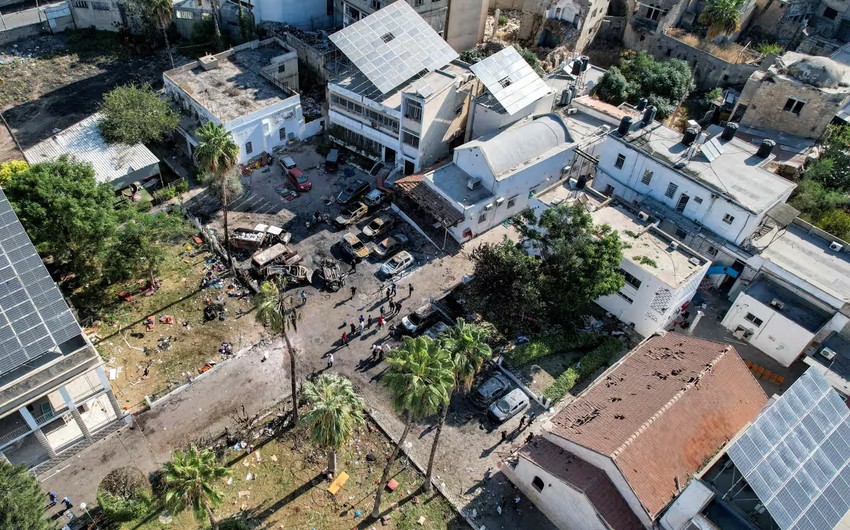Although the parties to the conflict blamed each other for the shelling of Al-Ahli hospital in the Gaza Strip on the evening of October 17, the overwhelming majority of evidence points against Palestinian militants, and the number of casualties is exaggerated, according to an article in The Guardian, Report informs.
Palestinian officials blamed an Israeli airstrike for the explosion that Gaza’s health ministry said on Wednesday had killed 471 Palestinians and wounded 314 others.
Israel has said the blast was caused by a failed rocket launch by the Palestinian Islamic Jihad militant group, which has denied blame.
Forensic reviewing of open source videos and news broadcasts have given a clearer picture of what happened on Tuesday night.
They show the impact on the hospital occurring at 6.59pm local time, with a massive orange plume visible in the dark horizon, engulfing the building.
A video, broadcast by Al Jazeera and verified by the Guardian, appears to show an airborne weapon following a rising trajectory over Gaza and bursting into flames in mid air. Moments later an explosion is seen at the hospital.
The first local reports of the blast started to come in between 7pm and 7.20pm.
Throughout the day the Telegram channels of Hamas’s armed wing, al-Qassam brigades, had been posting updates of attempted strikes into Israel.
Updates at 7pm described “bombardment by rockets” on Ashdod. Another, three minutes later, described an attack on Tel Aviv.
At 8.14pm, Hamas gave a further update, describing how al-Qassam brigades had targeted the northern Israeli city of Haifa with a R160 missile.
This was followed immediately by a press statement blaming Israel for the blast at the hospital which they called “an horrific massacre”.
The exact location of the impact on the ground where the blast occurred shows a crater in the compound of the hospital that experts describe as “fairly shallow”.
Marc Garlasco, a former Pentagon chief of high value targeting during the Iraq war in 2003, told the Guardian: “The number [of casualties] is astronomically high, an absolute high range of all time if true.
“The crater is not consistent with an airstrike, it is more likely to be a weapon that failed and released its payload over a wide area. The crater and surrounding damage is also not consistent with a JDAM aerial bomb. The hole on the ground occurred from kinetic energy.”
The JDAM, or joint direct attack munition, is a precision-guided air-to-surface weapon system that is part of the Israeli arsenal provided by the US.
Israel has said it used 6,000 bombs in the first six days of the conflict, more than the US used in a year during its operations in Afghanistan and double what the US-led coalition used against Islamic State in Iraq and Syria in a month.
Justin Bronk, the senior research fellow for airpower and military technology at RUSI in London, said that while the results were not conclusive, no crater or obvious shrapnel pattern consistent with standard JDAM bombs was visible in images of the aftermath.
“If this is the extent of the damage then I’d say an airstrike looks less likely than a rocket failure causing an explosion and fuel fire,” he added.
In the hours after the blast, doctors held a bleak press conference surrounded by dead bodies lying on the floor in heaps.
The hospital had also been targeted last week, sustaining damage to the top floor of the new diagnostic center and the ultrasound in the mammography room on the second floor.
About 5,000 people left after the first warning, he said. But many returned when airstrikes pummeled the neighborhood, hoping the hospital compound might be a relative haven amid Israel’s blanket evacuation order that effectively turned the whole city into a target.


 https://static.report.az/photo/25468091-cb48-34bb-8fd1-f21a41bc7f38.jfif
https://static.report.az/photo/25468091-cb48-34bb-8fd1-f21a41bc7f38.jfif

